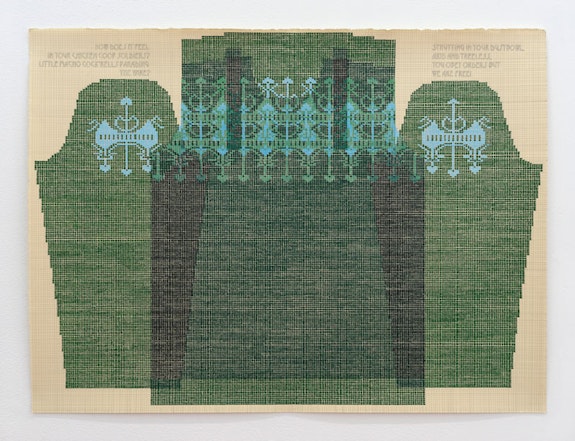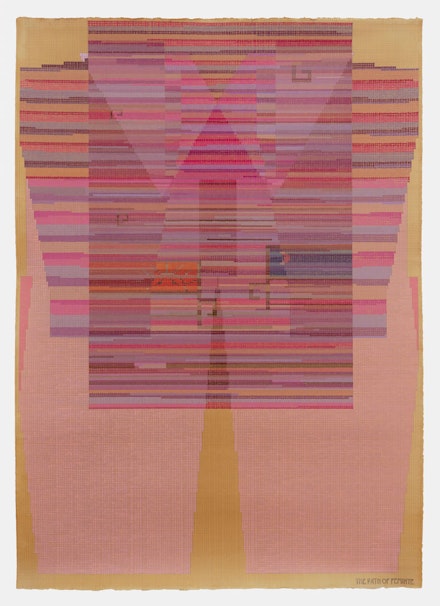ArtSeen
Ellen Lesperance: Lily of the Arc Lights
On View
Derek EllerSeptember 6 – October 7, 2018
New York
The ten shimmering gouaches at Ellen Lesperance’s solo show at Derek Eller Gallery introduce an artist whose execution and ideas complement each other with rare precision. The works extend Lesperance’s research on the Greenham Common Women’s Peace Camp, a 1981 action by a group of women from Cardiff, Wales. Calling themselves “Women for Life on Earth,” they traveled to Greenham Common in Berkshire, England to disrupt the operations of a United States Air Force (USAF) cruise missile base. When they requested a meeting with the Secretary of Defense, Francis Pym, to inform him of their intention to occupy Greenham Common, he denied their request with the taunt that they could stay as long as they liked. Pym got more than he bargained for: the Greenham Common Women’s Peace Camp surrounded the missile base for the next twenty years with multiple encampments of protestors, numbering at times in the thousands. Their non-violent actions added fire to the growing public outcry over nuclear proliferation in NATO member states, pressuring the British government to disarm. Ultimately, the USAF abandoned the base, shipping the missiles back to America in the early 1990s.
Lesperance’s pieces celebrate the protestors’ victory by referencing traditional “women’s work,” such as knitting or sewing, and by using color combinations usually dismissed as pretty or decorative. In doing so, she suggests the power the camp—with its typically “feminine” virtues of patience, persistence, and mutual support—wielded over the military culture of the base they surrounded, which glorified aggression, domination, and competition. Many of the works on view commemorate images of the protestors’ clothing, whose designs she replicates using a knitting system known as Symbolcraft, which is capable of diagramming any knitting pattern as a matrix of different stitching symbols. Lesperance then copies these stitches onto paper through thousands of tiny, many-colored squares of gouache, each laboriously gridded out with minute pencil marks. She dyes each page of paper in tea to give it a slightly aged look, and gently modulates her colors in large segments to the give the illusion of transparency as the colors darken in the overlapping segments. For example, “How Does It Feel In Your Chicken Coop Soldiers? Little Macho Cock-rells Parading the Wire? Strutting in Your Dustbowl, Arid and Treeless, You Obey Orders, But We Are Free!” (2018) shows a sewing pattern for a sweater in which the sleeves, the front, and the back appear in varying shades of green and blue that become darker where they appear to intersect. As with most of the other works in the show, Lesperance writes the title directly on the page in an Arts and Crafts font—in this case, in the two top corners. In her choice of lettering, Lesperance likely alludes to the movement’s utopian view that cooperation, rather than competition, should prevail in social relations. Next to the gouache, on a shelf, sits a folded green and blue sweater in a matching pattern.
While conceptually satisfying, How Does it Feel in Your Chicken Coop misses the vibrant color choices of Lesperance’s other pieces. As If the Earth Itself Was Ours by New Covenant (2018) includes a cascading rainbow that flows from the top of the page down to what looks like a pair of underwear, or perhaps a kerchief, in a red-and-white checkered pattern, followed by grey leggings. A central gap in these layers creates a bright vertical band that picks up the rainbow motif in the upper half of the page. The rainbow in the Bible symbolized God’s joyful pact with Noah, guaranteeing a new world awaited him after the devastation of the flood. Thanks, in part, to the mothers and daughters of the Greenham Common Women’s Peace Camp, the devastation of nuclear war receded to some degree when the USAF dismantled the missile site, promising a more peaceful world.
Of all the gouaches, The Path of Feminye (2018) works best in both its visual appeal and the message it brings to the show. It has an analogous palette of pinks, plums, reds, and ochers—colors that occupy contiguous regions of the color wheel and thus reinforce each other in a cooperative, non-competitive way. Pink has a weak connotation precisely because of its feminine associations, but here, in another example of the ironic turnabout Lesperance favors, it becomes a source of strength. In the upper center of The Path of Feminye, she produces a darkening and intensification of the pink and plum colors in the shape of an arrow pointing up. It is a radiant, powerful sign, abetted by the forms and colors around it. Repurposing the phallic connotations of the arrow, Lesperance points in the direction women’s lives will take if they emulate the feminist cooperation of the Greenham Common Women’s Peace Camp: up.




